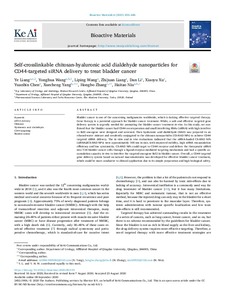Self-crosslinkable chitosan-hyaluronic acid dialdehyde nanoparticles for CD44-targeted siRNA delivery to treat bladder cancer
Liang Ye; Wang Yonghua; Wang Liping; Liang Zhijuan; Li Dan; Xu Xiaoyu; Chen Yuanbin; Yang Xuecheng; Zhang Hongbo; Niu Haitao
Self-crosslinkable chitosan-hyaluronic acid dialdehyde nanoparticles for CD44-targeted siRNA delivery to treat bladder cancer
Liang Ye
Wang Yonghua
Wang Liping
Liang Zhijuan
Li Dan
Xu Xiaoyu
Chen Yuanbin
Yang Xuecheng
Zhang Hongbo
Niu Haitao
KEAI PUBLISHING LTD
Julkaisun pysyvä osoite on:
https://urn.fi/URN:NBN:fi-fe2021042825718
https://urn.fi/URN:NBN:fi-fe2021042825718
Tiivistelmä
Bladder cancer is one of the concerning malignancies worldwide, which is lacking effective targeted therapy. Gene therapy is a potential approach for bladder cancer treatment. While, a safe and effective targeted gene delivery system is urgently needed for prompting the bladder cancer treatment in vivo. In this study, we confirmed that the bladder cancer had CD44 overexpression and small interfering RNAs (siRNA) with high interfere to Bcl2 oncogene were designed and screened. Then hyaluronic acid dialdehyde (HAD) was prepared in an ethanol-water mixture and covalently conjugated to the chitosan nanoparticles (CS-HAD NPs) to achieve CD44 targeted siRNA delivery. The in vitro and in vivo evaluations indicated that the siRNA-loaded CS-HAD NPs (siRNA@CS-HAD NPs) were approximately 100 nm in size, with improved stability, high siRNA encapsulation efficiency and low cytotoxicity. CS-HAD NPs could target to CD44 receptor and deliver the therapeutic siRNA into T24 bladder cancer cells through a ligand-receptor-mediated targeting mechanism and had a specific accumulation capacity in vivo to interfere the targeted oncogene Bcl2 in bladder cancer. Overall, a CD44 targeted gene delivery system based on natural macromolecules was developed for effective bladder cancer treatment, which could be more conducive to clinical application due to its simple preparation and high biological safety.
Kokoelmat
- Rinnakkaistallenteet [27094]
